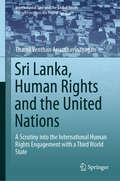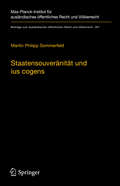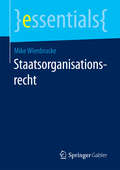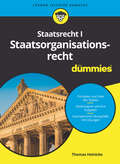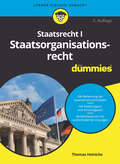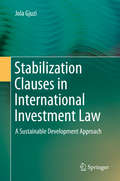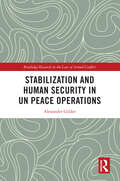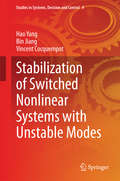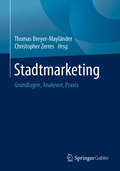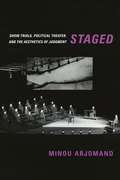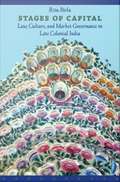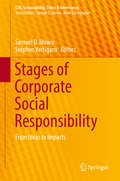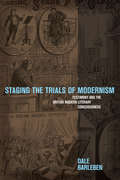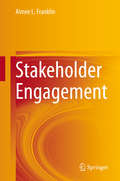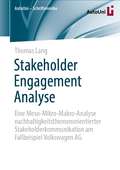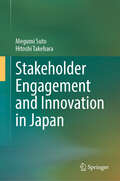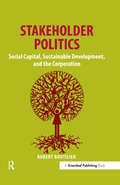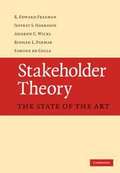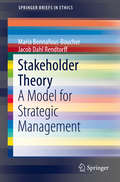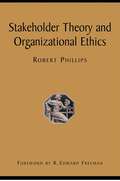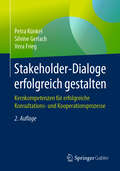- Table View
- List View
Sri Lanka, Human Rights and the United Nations: A Scrutiny into the International Human Rights Engagement with a Third World State (International Law and the Global South)
by Thamil Venthan AnanthavinayaganThis book examines the engagement between the United Nations’ human rights machinery and the respective governments since Sri Lanka (then Ceylon) joined the United Nations.Sri Lanka has a long and rich history of engagement with international human rights instruments. However, despite its active membership in the UN, the country’s post-colonial trials and tribulations are emblematic of the limited influence the international organisation has exerted on this country in the Global South.Assessing the impact of this international engagement on the country’s human rights infrastructure and situation, the book outlines Sri Lanka’s colonial and post-colonial development. It then considers the development of a domestic human rights infrastructure in the country. It also examines and analyzes Sri Lanka’s engagement with the UN’s treaty-based and charter-based human rights bodies, before offering conclusions concerning the impact of said engagement. The book offers an innovative approach to gauging the impact of international human rights engagement, while also taking into account the colonial and post-colonial imperatives that have partly dictated governmental behaviour. By doing so, the book seeks to combine and analyse international human rights law, post-colonial critique, studies on biopower, and critical approaches to international law. It will be a useful resource not only for scholars of international law, but also for practitioners and activists working in this area.
St Antoninus of Florence on Trade, Merchants, and Workers (Toronto Studies in Medieval Law #5)
by Jason Aaron BrownSaint Antoninus of Florence was a Dominican friar and archbishop of Florence from 1446 to 1459. He composed one of the most comprehensive manuals of moral theology, the Summa, which has long been counted among the more copious, influential, and rewarding medieval sources. St Antoninus of Florence on Trade, Merchants, and Workers gives an orientation to the life and teaching of Saint Antoninus, focusing on his writings on economic ethics, and includes a critical edition of his original Latin text with an English translation. The book provides an extensive introduction to his thought, situating it in its intellectual and social context, and elucidates the development of medieval economic and moral doctrines in law and theology. Jason Aaron Brown examines historians’ arguments about Italian business culture in the wake of the medieval “Commercial Revolution” and whether this culture can be considered capitalistic. He concludes that while Saint Antoninus is surprisingly modern in the economic concepts he deploys, his moral teaching on proper means and ends in the marketplace stood against certain nascent capitalistic tendencies in fifteenth-century Florence. Through examination of the manuscripts, this book opens a window into a premodern author’s writing process that will be of interest to scholars of medieval manuscripts and literary production.
St. Thomas Aquinas On Politics And Ethics (Norton Critical Editions)
by Thomas Aquinas Paul E. SigmundThe selections not only include St. Thomas Aquinas's views ongovernment, law, war, property, and sexual ethics, but also provide thetheological, epistemological, and psychological background for hispolitical and ethical thought, including the Five Proofs on theexistence of God and Aquinas's theories of knowledge, the soul, thepurpose of man, and the order of the universe. Throughout the book,footnotes explain technical terms and historical, biblical, andclassical references. "Backgrounds and Sources" follows the text, with selections from thewritings of Aristotle, St. Augustine, and Dionysius the Areopagite. "Interpretations" traces Aquinas's influence on medieval thought, onRoman Catholicism during the Renaissance, on early modern politicalthought (Richard Hooker and Francisco Suarez), on nineteenth-andtwentieth-century papal social thought, and on contemporary ChristianDemocratic political parties in Europe and Latin America. The volume concludes with "Contemporary Problems in Thomistic Ethics",which contains eight analyses of the influence of Aquinas's thought onmodern debates on war, contraception, and abortion. A Selected Bibliography is included.
Staatensouveränität und ius cogens: Eine Untersuchung zu Ursprung und Zukunftsfähigkeit der beiden Konzepte im Völkerrecht (Beiträge zum ausländischen öffentlichen Recht und Völkerrecht #287)
by Martin Philipp SommerfeldDas Buch untersucht das Verhältnis von Staatensouveränität und ius cogens aus ideen- und rechtsgeschichtlicher Perspektive und ist bestrebt, den rechtshistorischen Befund für die aktuelle völkerrechtliche Konstitutionalisierungsdebatte fruchtbar zu machen. Während das Konzept des ius cogens im aktuellen Völkerrecht eng mit dem Ruf nach der Konstitutionalisierung einer Internationalen (Rechts-)Gemeinschaft verbunden wird, gilt das Konzept der Staatensouveränität als Hort des Unilateralismus und rücksichtslosen Autonomiestrebens. Der Autor vertritt demgegenüber eine differenziertere Sichtweise. Er unternimmt eine ideenhistorische Untersuchung der Ursprünge beider Konzepte und gelangt zu dem Befund, dass die Konzepte der Staatensouveränität und des ius cogens auf den gleichen antik-römischen Vorstellungen über das ius publicum aufbauen. Er analysiert diese römisch-antiken Gedanken und zeigt, wie sie – etwa in Form der quod-omnes-tangit-Formel – prägend für Vorstellungen von zwingendem supranationalem Recht und „souveräner“ Herrschaft in Mittelalter und Moderne wurden. Nach Auffassung des Autors gibt es demnach keine „Geburtsstunde“ der Staatensouveränität in der Antike oder dem Mittelalter, sondern vielmehr eine Gedankenevolution, die sich von den gemeinsamen antiken Ursprüngen bis zu modernen Vorstellungen über das ius cogens und die Staatensouveränität verfolgen lässt. Vor dem Hintergrund dieses Befundes führt das Buch aus, dass auch im heutigen Völkerrecht die beiden Konzepte als Ausfluss des gleichen „republikanischen“ Grundprinzips verstanden und so miteinander harmonisiert werden könnten. Dabei macht das Buch aber deutlich, dass ein durch rechtshistorische Analyse vermitteltes Verständnis bestenfalls als Inspirationsquelle für die künftige Ausgestaltung des Rechts dienen mag, rechtshistorische Befunde aber keinesfalls als rechtliche Argumente dienen können.
Staatliche Souveränität: Zu einem Schlüsselbegriff der Staatsdiskussion (essentials)
by Rüdiger VoigtDas essential erläutert zunächst die Begriffsgeschichte und Bedeutung der Souveränität für den Staat des 21. Jahrhunderts und beschreibt die drei Typen Parlamentssouveränität, Rechts- bzw. Verfassungssouveränität sowie (direkte) Volkssouveränität. Anschließend analysiert der Autor den Begriff der nationalstaatlichen Souveränität im Kontext der Globalisierung, Internationalisierung sowie Europäisierung und stellt die Auswirkungen des globalen Finanzkapitalismus auf die nationalstaatliche Souveränität dar. Die Übertragung von Kernkompetenzen an die Europäische Union bei gleichzeitigem Souveränitätsverlust der Mitgliedstaaten und die Kontroverse zwischen Universalisten, Nationalisten und Partikularisten werden kritisch diskutiert. Abschließend liefert das essential Ansatzpunkte zu einer Erneuerung der Volkssouveränität im demokratischen Rechtsstaat.
Staatsorganisationsrecht (essentials)
by Mike WienbrackeDas essential stellt auf kompakte und #65533;bersichtliche Weise die Grundz#65533;ge des Staatsorganisationsrechts der Bundesrepublik Deutschland dar. Mike Wienbracke erl#65533;utert neben grundlegenden Begriffen wie ,,Staat" und ,,Verfassung" die Staatsstrukturprinzipien des Grundgesetzes, die obersten Staatsorgane des Bundes sowie die Staatsfunktionen. Der Leser erh#65533;lt damit einen Einblick u. a. in folgende Themen: (indirekte und direkte) Demokratie, Republik, Rechtsstaat, Bundesstaat und Sozialstaat; Bundestag, Bundesrat, Bundesregierung, Bundespr#65533;sident und Bundesverfassungsgericht; Gesetzgebung, vollziehende Gewalt und Rechtsprechung; Verfassungs#65533;nderung, R#65533;ckwirkung, Verh#65533;ltnism#65533;#65533;igkeitsgrundsatz, soziale Sicherheit und Gerechtigkeit, Wahlrechtsgrunds#65533;tze, 5%-Klausel, Grundmandatsklausel, #65533;berhang- und Ausgleichsmandate, Immunit#65533;t und Indemnit#65533;t, konstruktives Misstrauensvotum, Vertrauensfrage, Gewaltenteilung, Gesetzgebungskompetenz, Gesetzgebungsverfahren, Einspruchs- und Zustimmungsgesetze.
Staatsorganisationsrecht I für Dummies (Für Dummies)
by Thomas HeinickeWer wählt den Bundeskanzler? Was sind die Aufgaben des Bundespräsidenten? Wie war das nochmal mit der Gewaltenteilung? Wann kommt das Bundesverfassungsgericht zum Einsatz? Staatsorganisationsrecht ist viel spannender als Sie vielleicht denken! In diesem Buch erfahren Sie Wissenswertes über die Staatsorgane Bundestag, Bundesrat, Bundesregierung und Bundespräsident, aber auch den Gemeinsamen Ausschuss und das Bundesverfassungsgericht. Thomas Heinicke stellt Ihnen die Staatsstrukturprinzipien nach Artikel 20 des Grundgesetzes vor und erklärt Ihnen die Staatsfunktionen des Bundes und die Ziele, die der Staat laut Grundgesetz verfolgen soll. Nach der Lektüre dieses Buches sind Sie in jedem Fall mündiger Bürger und, falls Staatsorganisationsrecht zu Ihrem Studium gehört, auch fit für die Prüfung.
Staatsrecht I Staatsorganisationsrecht für Dummies (Für Dummies)
by Thomas HeinickeDas Grundgesetz ist seit über 70 Jahren ein Garant für Freiheit, Demokratie und Rechtsstaatlichkeit. Thomas Heinicke stellt Ihnen die Staatsstrukturprinzipien nach Artikel 20 des Grundgesetzes, die Staatsfunktionen des Bundes und die Ziele des Staates vor. Sie erfahren, welche Staatsorgane es gibt, welche Aufgaben diese haben und wie sie zusammenarbeiten. Nach der Lektüre dieses Buchs sind Sie in jedem Fall ein mündiger Bürger! Und können sich, falls Staatsorganisationsrecht zu Ihrem Studium gehört, anhand der Musterklausuren mit ausformulierten Lösungen auf Prüfungen vorbereiten.
Staatsrecht II: Grundrechte für Dummies (Für Dummies)
by Thomas HeinickeThomas Heinicke behandelt in seinem zweiten Buch zum Staatsrecht die wichtigsten Grundrechte für Prüfung und Praxis. Er führt zunächst in die allgemeine Grundrechtslehre ein und stellt den Prüfungsaufbau von Grundrechten und das Recht der Verfassungsbeschwerde dar. Im Hauptteil behandelt der Autor die einzelnen Grundrechte. Fallbearbeitungen runden das Buch ab.
Stabilization Clauses in International Investment Law: A Sustainable Development Approach
by Jola GjuziThis book analyzes the tension between the host state’s commitment to provide regulatory stability for foreign investors – which is a tool for attracting FDI and generating economic growth – and its evolving non-economic commitments towards its citizens with regard to environmental protection and social welfare. The main thesis is that the ‘stabilization clause/regulatory power antinomy,’ as it appears in many cases, contradicts the content and rationale of sustainable development, a concept that is increasingly prevalent in national and international law and which aims at the integration and balancing of economic, environmental, and social development. To reconcile this antinomy at the decision-making and dispute settlement levels, the book employs a ‘constructive sustainable development approach,’ which is based on the integration and reconciliation imperatives of the concept of sustainable development as well as on the application of principles of law such as non-discrimination, public purpose, due process, proportionality, and more generally, good governance and rule of law. It subsequently re-conceptualizes stabilization clauses in terms of their design (ex-ante) and interpretation (ex-post), yielding stability to the benefit of foreign investors, while also mitigating their negative effects on the host state’s power to regulate.
Stabilization and Human Security in UN Peace Operations (Routledge Research in the Law of Armed Conflict)
by Alexander GilderUN peace operations are increasingly asked to pursue stabilization mandates with lofty expectations of being able to stabilize conflict zones, achieve national reconciliation, and rebuild state legitimacy. This book investigates the relationship between UN stabilization mandates and the concept of ‘human security’. The book is divided into three parts. Part I outlines the emergence of stabilization and other trends in peacekeeping practice and outlines an analytical framework of human security. Part II applies the analytical framework to case studies of MINUSMA, MINUSCA, and UNMISS examining issues, such as human rights, empowerment, protection, and vulnerability. In Part III the book draws out several concerns that arise from stabilization mandates, including the militarisation of UN peace operations and the consequences under international humanitarian law, the risks of close cooperation with the host state and engagement in counter-terror activities, and the potential clash between peacebuilding activities and militarisation. The book will be a valuable resource for academics, policymakers and practitioners working on UN peacekeeping generally, and those specifically looking at stabilization, from the perspective of international relations, international law, peace and conflict studies, security studies and human rights.
Stabilization of Switched Nonlinear Systems with Unstable Modes
by Hao Yang Bin Jiang Vincent CocquempotThis book provides its reader with a good understanding of the stabilization of switched nonlinear systems (SNS), systems that are of practical use in diverse situations: design of fault-tolerant systems in space- and aircraft; traffic control; and heat propagation control of semiconductor power chips. The practical background is emphasized throughout the book; interesting practical examples frequently illustrate the theoretical results with aircraft and spacecraft given particular prominence. Stabilization of Switched Nonlinear Systems with Unstable Modes treats several different subclasses of SNS according to the characteristics of the individual system (time-varying and distributed parameters, for example), the state composition of individual modes and the degree and distribution of instability in its various modes. Achievement and maintenance of stability across the system as a whole is bolstered by trading off between individual modes which may be either stable or unstable or by exploiting areas of partial stability within all the unstable modes. The book can be used as a reference for academic research on switched systems or used by graduate students of control theory and engineering. Readers should have studied linear and nonlinear system theory and have some knowledge of switched and hybrid systems to get the most from this monograph.
Stadtmarketing: Grundlagen, Analysen, Praxis
by Thomas Breyer-Mayländer Christopher ZerresStadtmarketing ist das Aufgabenfeld verschiedener Disziplinen und Berufsgruppen. Neben Marketingfachleuten aus Wissenschaft, Beratung und Praxis beschäftigt es auch Verwaltungsexperten oder Praktiker aus Handel und Gastronomie. Voraussetzung und Basis für erfolgreiche Marketingstrategien ist daher eine interdisziplinäre, konstruktive und flexible Zusammenarbeit aller Beteiligten. Dieses Buch gibt einen Überblick über die Grundlagen des Stadtmarketing und liefert Ansatzpunkte für die Weiterentwicklung von Städten, Kommunen und Regionen. Es beleuchtet die wichtigen Aspekte Transformation, Mobilität und Infrastruktur und bietet gezielte Anregungen für die Marketingpraxis. Zudem werden Beispiele erfolgreicher praktischer Umsetzungen aufgezeigt, wie etwa in Freiburg, Frankfurt, Neumünster, Offenburg, Jena, Mainz oder Leipzig.Über 40 renommierte Branchenexperten beschreiben, was die Branche bewegt und was es in Zukunft zu beachten gilt. Das Werk bietet Neulingen und Quereinsteigern aus anderen Fachgebieten sowie Studierenden großen Nutzwert. Außerdem enthält es wegweisende Anregungen für erfahrene Praktiker, die die Kommunikation und Kooperation mit Stakeholdern aus unterschiedlichen Fachdisziplinen verbessern möchten und zugleich nach Impulsen für die eigene Arbeit suchen.
Staged: Show Trials, Political Theater, and the Aesthetics of Judgment
by Minou ArjomandTheater requires artifice, justice demands truth. Are these demands as irreconcilable as the pejorative term “show trials” suggests? After the Second World War, canonical directors and playwrights sought to claim a new public role for theater by restaging the era’s great trials as shows. The Nuremberg trials, the Eichmann trial, and the Auschwitz trials were all performed multiple times, first in courts and then in theaters. Does justice require both courtrooms and stages?In Staged, Minou Arjomand draws on a rich archive of postwar German and American rehearsals and performances to reveal how theater can become a place for forms of storytelling and judgment that are inadmissible in a court of law but indispensable for public life. She unveils the affinities between dramatists like Bertolt Brecht, Erwin Piscator, and Peter Weiss and philosophers such as Hannah Arendt and Walter Benjamin, showing how they responded to the rise of fascism with a new politics of performance. Linking performance with theories of aesthetics, history, and politics, Arjomand argues that it is not subject matter that makes theater political but rather the act of judging a performance in the company of others. Staged weaves together theater history and political philosophy into a powerful and timely case for the importance of theaters as public institutions.
Stages of Capital: Law, Culture, and Market Governance in Late Colonial India
by Ritu BirlaIn Stages of Capital, Ritu Birla brings research on nonwestern capitalisms into conversation with postcolonial studies to illuminate the historical roots of India's market society. Between 1870 and 1930, the British regime in India implemented a barrage of commercial and contract laws directed at the "free" circulation of capital, including measures regulating companies, income tax, charitable gifting, and pension funds, and procedures distinguishing gambling from speculation and futures trading. Birla argues that this understudied legal infrastructure institutionalized a new object of sovereign management, the market, and along with it, a colonial concept of the public. In jurisprudence, case law, and statutes, colonial market governance enforced an abstract vision of modern society as a public of exchanging, contracting actors free from the anachronistic constraints of indigenous culture. Birla reveals how the categories of public and private infiltrated colonial commercial law, establishing distinct worlds for economic and cultural practice. This bifurcation was especially apparent in legal dilemmas concerning indigenous or "vernacular" capitalists, crucial engines of credit and production that operated through networks of extended kinship. Focusing on the story of the Marwaris, a powerful business group renowned as a key sector of India's capitalist class, Birla demonstrates how colonial law governed vernacular capitalists as rarefied cultural actors, so rendering them illegitimate as economic agents. Birla's innovative attention to the negotiations between vernacular and colonial systems of valuation illustrates how kinship-based commercial groups asserted their legitimacy by challenging and inhabiting the public/private mapping. Highlighting the cultural politics of market governance, Stages of Capital is an unprecedented history of colonial commercial law, its legal fictions, and the formation of the modern economic subject in India.
Stages of Corporate Social Responsibility
by Samuel O. Idowu Stephen VertigansThis book presents a multidisciplinary and multifaceted view of the state of corporate social responsibility (CSR) development in organizations in different industries around the world. It is based on the assumption that companies today must shift their focus to their long-term prosperity and the complex and interrelated environmental, social, economic and political ecosystems within which they function. The book tracks ideas through to impacts, offering unique perspectives on stimulating topics such as awareness among female entrepreneurs in Nigeria, views of upper-management in Polish firms, Japanese CSR strategies and the social relevance of corporate initiatives, pragmatic approaches of CSR design principles in Scandinavia and many more. The book collects not only examples from different countries and global regions, but also cases from a diverse range of globally relevant industries. It discusses the different stages of CSR development at a professional, conceptual and strategic level, and integrates them into a comprehensive framework to define the adequate course of action for each stage.
Staging the Trials of Modernism: Testimony and the British Modern Literary Consciousness
by Dale BarlebenIn Staging the Trials of Modernism, Dale Barleben explores the interactions among literature, cultural studies, and the law through detailed analyses of select British modern writers including Oscar Wilde, Joseph Conrad, Ford Madox Ford, and James Joyce. By tracing the relationships between the literature, authors, media, and judicial procedure of the time, Barleben illuminates the somewhat macabre element of modern British trial process, which still enacts and re-enacts itself throughout contemporary judicial systems of the British Commonwealth. Using little seen legal documents, like Ford's contempt trial decision, Staging the Trials of Modernism uncovers the conversations between the interior style of British Modern authors and the ways in which law began rethinking concepts like intent and the subconscious. Barleben’s fresh insights offer a nuanced look into the ways in which law influences literary production.
Stakeholder Engagement
by Aimee L. FranklinThis book analyses the relationship between stakeholder engagement practices and organizational sustainability across sectors and disciplines. It illuminates the relationships between the inputs and processes, vital for all kinds of organizations to engage stakeholders. Then, it describes the mutually-valued outcomes that can produce broader organizational impacts and sustainability. Each chapter is structured around a logic model that provides an analytical framework to engage the reader in strategic analysis and offer practical applications for adaptation and implementation in any organization. The book encourages the reader to systematically consider the descriptive, instrumental, and normative aspects of stakeholder theory as a precursor to designing stakeholder engagement practices.
Stakeholder Engagement Analyse: Eine Meso-Mikro-Makro-Analyse nachhaltigkeitsthemenorientierter Stakeholderkommunikation am Fallbeispiel Volkswagen AG (AutoUni – Schriftenreihe #153)
by Thomas LangAm Fallbeispiel der Volkswagen AG Nachhaltigkeit werden erstmalig auf der Grundlage eines sozialtheoretisch inspirierten Mehrebenen-Analysemodells die Wahrnehmungen und Zuschreibungen von Unternehmensverantwortung (Corporate Responsibility) durch 33 nichtmarktliche Stakeholder aus den drei Bezugsgruppen Wissenschaft und Forschung, Politik und Verbände sowie NGOs untersucht. Die qualitative Fallstudie beschreibt kenntnisreich und detailliert, wie der Volkswagen-Konzern mit seinen wesentlichen, nichtmarktlichen Stakeholdergruppen interagiert. Den theoretischen Bezugsrahmen der Arbeit bilden Anthony Giddens Theorie der Strukturation, Edward R. Freemans Stakeholder-Management- und Amartya Sens Capability-Ansatz.
Stakeholder Engagement and Innovation in Japan
by Hitoshi Takehara Megumi SutoThis book focuses on the linkage between corporate social responsibility (CSR) engagement and innovation strategies in the context of Japanese firms beginning in the late 2000s. Since that time, the firms have faced transformations in their business models and CSR activities in the face of global technological competition. The novelty of this book is that it carefully identifies the channels linking CSR and innovation through employee motivation for creativity and investor awareness of environmental, social, and governance (ESG) issues. As well, the book sheds light on the role of independent sustainability rating agencies as information intermediaries in this linkage. It empirically examines whether and how internal and external stakeholder engagement influences organizational innovation capability and the impact of ESG ratings on that relationship. This present work helps to provide a comprehensive understanding of the integration of multi-stakeholder engagement in corporate innovation strategies to survive in changing social and environmental circumstances, with insight into the role of information intermediaries in the integration process. The book has practical implications for strategic CSR to achieve social and environmental sustainability, which are particularly important in Japan.
Stakeholder Politics: Social Capital, Sustainable Development, and the Corporation
by Robert BoutilierThe war is over. The largest corporations in the world are now committed to sustainability. But, behind the public relations gloss, corporate executives and managers are perplexed. The majority of them have a genuine desire to work in an ethical and sustainable manner. Yet, when they engage with their stakeholders for that purpose, they unexpectedly encounter a world of hardball politics full of hostile activists, self-interested elites and unpredictable attacks. Unfortunately, corporate management is too often unskilled in this rough-and-tumble world. While managers rely on facts and rational analysis, their self-appointed critics have mastered the arts of political discourse, issue framing and media manipulation. At the same time, as corporations extend their global reach, their third-world stakeholder communities are beset with a variety of poverty-maintaining and sustainability-thwarting conditions. In many parts of the world, communities suffer from entrenched divisions, exclusion from power, unpredictable violence and economic dependency. In order to both reduce reputational risk and to contribute to sustainable development, companies need the equivalent of roadmaps of the socio-political terrain in their stakeholder networks.This book moves on to next challenge of giving companies what they need now: namely, "how to" guides addressing the twin problems of firstly maintaining political legitimacy (talking the talk), and, secondly, promoting sustainable development (walking the walk). They need to learn how to both play stakeholder politics and collaborate with stakeholders towards sustainability goals. Most companies have already encountered or anticipated the barriers that this book addresses, and managers will recognize the dilemmas described.Stakeholder Politics is the first book to offer a method for classifying and dealing with these socio-political problems.The book presents a typology of stakeholder networks that will help managers and community leaders identify and improve the social capital patterns in their own networks. Once they know what patterns they have, they can move their networks towards those that foster sustainable community development. The author describes vivid cases in which managers and community stakeholders have already used the approach successfully. At the same time, managers get handy tools for predicting and avoiding community-level socio-political risk around stakeholder issues: most notably, the Stakeholder 360 which has been successfully used in Canada and Australia with large groups of managers learning about stakeholder engagement.The book has been written for an audience of both managers and academics. Those working in developing countries with difficult stakeholder issues will find it indispensable.
Stakeholder Theory
by R. Edward Freeman Jeffrey S. Harrison Andrew C. Wicks Bidhan Parmar Simone De ColleIn 1984, R. Edward Freeman published his landmark book, Strategic Management: A Stakeholder Approach, a work that set the agenda for what we now call stakeholder theory. In the intervening years, the literature on stakeholder theory has become vast and diverse. This book examines this body of research and assesses its relevance for our understanding of modern business. Beginning with a discussion of the origins and development of stakeholder theory, it shows how this corpus of theory has influenced a variety of different fields, including strategic management, finance, accounting, management, marketing, law, health care, public policy, and environment. It also features in-depth discussions of two important areas that stakeholder theory has helped to shape and define: business ethics and corporate social responsibility. The book concludes by arguing that we should re-frame capitalism in the terms of stakeholder theory so that we come to see business as creating value for stakeholders.
Stakeholder Theory
by Jacob Dahl Rendtorff Maria Bonnafous-BoucherThis book provides an academic introduction to, and presentation and defence of stakeholder theory as a model for the strategic management of businesses and corporations, as well as of public organizations and institutions. The concept of the stakeholder is generally applied to parties that affect or are affected by the activities of private or public organizations. Distinct from shareholders, stakeholders are those individuals, entities or communities that have a connection with the activities of a corporation, a firm or an organization. The notion of the stakeholder is intimately linked to a conception of the business firm as an entity founded on negotiated governance, in which the maximization of value for the shareholder is not the ultimate criterion. In this model, issues and interests that are not directly associated with shareholders and investors, but which go beyond capital to encompass the concerns of civil society, are considered to be of central importance. This book provides a broad overview of stakeholder theory, presenting it as an ethical approach to strategic management that is both pragmatic and applicable to developing democratic practices within corporations, while at the same time suggesting ways in which elements of a social contract can be elaborated within the context of globalization.
Stakeholder Theory and Organizational Ethics
by Robert PhillipsBusiness ethics is a staple in the news today. One of the most difficult ethical questions facing managers is, To whom are they responsible? Organizations can affect and are affected by many different constituencies-these groups are often called stakeholders. But who are these stakeholders? What sort of managerial attention should they receive? Is there a legal duty to attend to stakeholders or is such a duty legally prohibited due to the shareholder wealth maximization imperative? In short, for whose benefit ought a firm be managed? Despite the ever growing importance of these questions, there is no comprehensive, theoretical treatment of the stakeholder framework currently in print. In Stakeholder Theory and Organizational Ethics, Robert Phillips provides an extended defense of stakeholder theory as the preeminent theory of organizational ethics today. Addressing the difficult question of what the moral underpinning of stakeholder theory should be, Phillips elaborates a "principle of stakeholder fairness" based on the ideas of the late John Rawls-the most prominent moral and political philosopher of the twentieth century. Phillips shows how this principle clarifies several long-standing questions in stakeholder theory, including: Who are an organization's legitimate stakeholders? What is the basis for this legitimacy? What, if any, are the limits of stakeholder theory? What is the relationship between stakeholder theory and other moral, political, and business ethical theories? Applying research from many related disciplines, Stakeholder Theory and Organizational Ethics is an overdue response to several long-standing and fundamental points of contention within business ethics and management theory.
Stakeholder-Dialoge erfolgreich gestalten: Kernkompetenzen für erfolgreiche Konsultations- und Kooperationsprozesse
by Petra Künkel Silvine Gerlach Vera FriegEin Buch über Stakeholder-Dialoge und ergebnisorientiertes ZusammenarbeitenKaum ein Thema ist so omnipräsent wie Nachhaltigkeit. Die Menschen von heute sind dafür verantwortlich, die Zukunft für die Generationen von morgen positiv zu gestalten. In der Regel scheitert dieses Vorhaben jedoch an den unterschiedlichen Zielen, Ansprüchen und Werten der einzelnen Akteure. Dieses Buch widmet sich daher dem Thema Stakeholder-Dialoge. Denn nur, wenn sich ein ebenso kooperativer wie dialogorientierter Ansatz findet, ist ein kollektives Handeln möglich.Gemeinsame Lösungen für aktuelle Herausforderungen sind keine ZukunftsvisionenDieses Buch über Stakeholder-Dialoge bietet neben einem konzeptionellen Rahmen ebenfalls viele Fallbeispiele und methodische Ansätze, die zeigen, wie leicht Personen unterschiedlichen Hintergrunds effizient miteinander arbeiten können. Die Instrumente und Konzepte, die eine erfolgreiche Umsetzung versprechen, entstanden aus den Erfahrungen und Reflektionen der Mitwirkenden in diesem Buch. Stakeholder-Dialoge sind zwingend erforderlich, um das Thema Nachhaltigkeit ganzheitlich betrachten und angehen zu können. Durch die individuellen Ziele findet die Arbeit in der Regel voneinander isoliert und im gegenseitigen Wettstreit statt. Kooperationsprozesse zwischen Unternehmen aus der Wirtschaft und fachkundigen Experten unter einer gemeinsamen Führung sind der erste Ansatz, um zusammen Verantwortung zu übernehmen.Erfahren Sie in diesem Buch, wie Stakeholder-Dialoge und ein CSR-Management zusammenhängenDie aktualisierte Ausgabe umfasst folgende Kapitel, die Ihnen einen tiefen Einblick in die Materie geben:• Stakeholder Dialoge - ein zentraler Ansatz zur Umsetzung nachhaltiger Entwicklung• Potenzialanalyse für die Anwendung von Stakeholder Dialogen• Formen von Stakeholder Dialogen und die Möglichkeit ihrer Umsetzung• Die Durchführung von Stakeholder Dialogen• Stakeholder Dialoge als Veränderungsmanagement• Kommunikation in Stakeholder Dialogen• Dialog als Grundprinzip von Konsultation und Kooperation• Erfolgsfaktoren für Stakeholder Dialoge• Prozessmonitoring in Stakeholder Dialogen• PraxistoolsDie einzelnen Teile des Buches sollen Ihnen dabei helfen, mittels Stakeholder-Dialogen den existierenden Status-Quo zu ändern.
